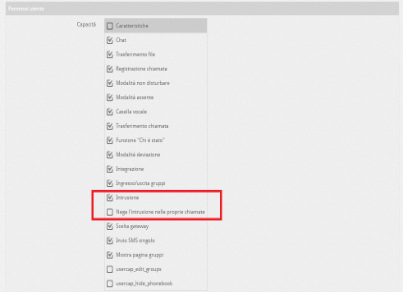Manuali VOIspeed®
How to create user profiles
In this article we will see how to create user profiles, or create a generic configuration with allowed and forbidden numbers and a specific set of capabilities to be assigned to user groups in order to facilitate the management of user settings over time.
First you need to access the Configuration -> User profiles section; here you can view the list of profiles already created and create new ones using the button ![]() .
.
The creation of a new profile requires the compilation of several fields that we see in detail:
| PROFILE DETAILS Here you can assign some general information to recognize the profile: Name: indicates the name of the profile and is the string with which it will be recognizable when it must be assigned to a user Description: allows you to assign a short description to the profile that facilitates its maintenance over time Immediately afterwards, the information that is already configurable for a normal user is resumed, that is: CALL PERMITS Prefixes Denied: Numbers or prefixes will never be able to call except in included among the prefixes always allowed. For example, if 0044 is entered as a denied area code, the user will not be able to make any calls to the United Kingdom. Prefixes always allowed: Numbers or prefixes that the user can ALWAYS call. Exit number: here you can assign the number that the user will present on outgoing calls. ATTENTION: the value set for this parameter at the User Profile level will in any case be less important than the value set for the same parameter at the user level. To simplify the work of the configurator, in the user configuration you have the information of the number that will be presented directly under the output number parameter.USER PERMISSIONSCapacity Chat: start a chat or send a short message (you can, however, receive or reply to messages) User area Company closures: allows the user to manage company closings |
 |
Contact resolution
In this section you can decide which and how much information to display for incoming calls on your extension. In detail:
Preferred address book application: VOIspeed provides native integration with various applications for which it acts as a centralizer of personal data; the integrated applications populate the VOIspeed address book by declaring their own application name. Here you can decide on the basis of which application you preferably want the name / number resolution of the caller to take place. Currently supported applications are:
- VOIspeed
- Polyedro
- Reviso
- Tustena CRM
- Alyante
Incoming call information: In this section you can decide how much and what information you want to display on your UI and on the display of the terminals used by the user when a call arrives. The order in which the options are presented is also the order in which they will be shown. In detail:
- Show company number description: allows you to view the description set in the configurator for the originally called company number (for incoming calls);
- Show group name: allows you to view the name of the group that received the call and to which you belong (for incoming calls);
- Show caller name (if in the directory): shows the name of the caller if the calling number is present in the switchboard directory
- Show caller surname (if in the directory): shows the surname of the caller if the calling number is present in the switchboard directory
- Show calling company (if in the address book): shows the name of the calling company if the calling number is present in the switchboard address book
USER TRAINING
The “User Training” function allows a user to intrude on a conversation between a switchboard user and an external interlocutor (it is not possible to intrude on internal calls). To use this function, you must be enabled within the VOIspeed configurator.
There is also a capability that disables the possibility of being intruded by training.
Go to the configurator in the section: Configuration → Users → Pencil symbol next to the user → “Profile” tab



